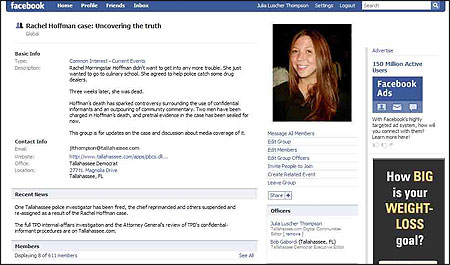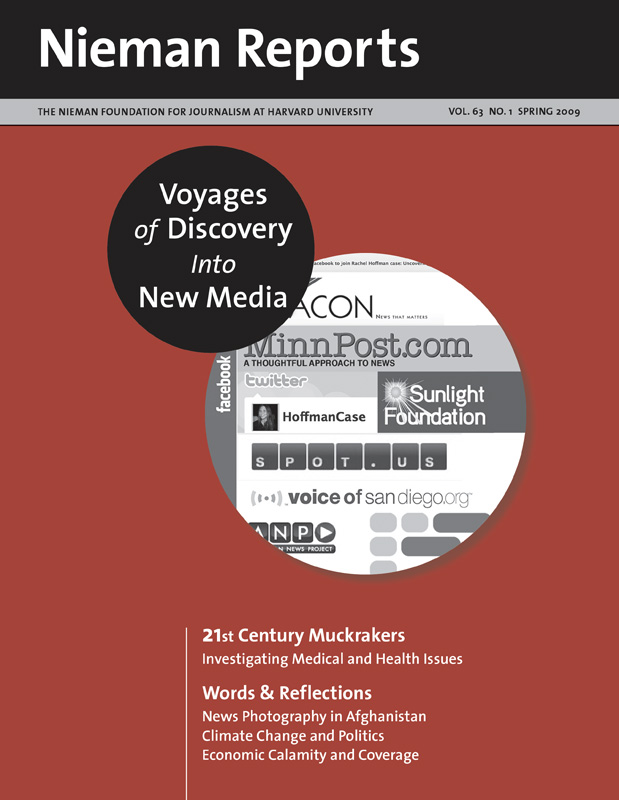When 23-year-old Rachel Hoffman, a recent college graduate, agreed to become a confidential informant, she could not have known she would soon become a household name in Tallahassee—and on the Web. On the night when she went to buy Ecstasy, cocaine and a gun from two men, her wire failed, police lost track of her, and she was killed in the botched drug sting.
EDITOR’S NOTE
Access all of the social media tools the Tallahassee Democrat used to distribute information about the Hoffman case »Those of us at the Tallahassee Democrat knew we had to get to the bottom of Hoffman’s story and hold local government and law enforcement accountable for any of their actions that might have contributed to her death. We also realized that her story would be of great interest to the community and her college-aged peers in particular, most of whom don’t read the daily newspaper. So we had to find different ways of reporting and bringing the story to them. With that in mind, over time we set up a Facebook group, a Twitter account, a YouTube channel, and a project page on our Web site that is dedicated to the Hoffman case.

The Tallahassee Democrat’s Facebook page, “Rachel Hoffman case: Uncovering the truth,” is at www.facebook.com/group.php?gid=47350501912.
Attracting a Young Audience
“Immediately we saw so much interest online and in the story chats,” lead reporter Jennifer Portman said of this case that quickly transitioned from that of a missing person to one in which a young woman was murdered while working for police. “Her friends were checking in with our Web site all the time. The morning she went missing, the first place her boyfriend checked was Tallahassee.com.”
Police initially blamed Hoffman for violating protocol but refused to release details about the case because it was part of an ongoing investigation. Then, shortly after a grand jury issued a scathing report about the Tallahassee Police Department’s handling of the case, a judge sealed pretrial evidence. All of this meant that law enforcement sources we might normally turn to in covering a murder were now evasive or silent. As Portman explained, “We had to talk to her friends, including her best friend and her family members, to start filling in some of those blanks of what had happened that night.”
Hoffman’s boyfriend and one of her close friends spoke with Portman on the condition they remain anonymous as sources; their information helped provide a turning point in our coverage of the case. They were able to tell Portman about Hoffman’s last night, and they also shared with her details of what they regarded as police negligence that those in law enforcement refused to admit. To dig for other relevant information, our reporters reached out to Hoffman’s friends and family through Facebook, sometimes using the social network to find sources.
When she was murdered in May, Hoffman had recently graduated from Florida State University (FSU), and most of the students were heading out of town for the summer. As the college students—some 65,000 of them—returned to Tallahassee in August, we increased our efforts to get this important story out in ways comfortable to them, which meant on the Web. Our hope was that our public service journalism would energize our young audience.
“Rachel Hoffman is someone that so many of those students can relate to,” Portman said. “She looks like them, she talks like them; they could so closely identify with her.”

Using Social Media
Facebook groups about Hoffman had already been created by her friends. So we used those groups as our starting point by inviting their members to join our new Facebook group, which we dedicated to keeping people updated with developments in the case and as a place for discussion about media coverage of it. This group has grown to have more than 600 members and, as we found out, some might not have known about the story if not for our newspaper using these social media tools.
Scott Ellington, 29, a self-employed software developer and FSU grad, was one such reader. He stumbled upon our Facebook coverage via the HoffmanCase Twitter account that the newspaper set up. As Ellington saw the Twitter updates, he was intrigued by a story with local impact that affected a young person. “She had an education, and she came from a well-to-do family,” Ellington said. “I’d say that reflects a lot of young people in this town.”
After following the updates on Twitter, Ellington also joined the Facebook group. “I’m not a news junkie by any means,” he said. “I like to filter my information so I don’t get a lot of stuff that I don’t care about.” When asked how Hoffman’s case had made it through his filter, Ellington paused before finding words to explain the connection: “A lot of people in my generation take a lot for granted when they think about mortality. They just think they’re insulated from this type of thing happening,” he said. “Also, it’s like you have an incompetence maybe in government that led to the death or was part of it.”
Although Hoffman’s case resonated with Ellington, he said that he wasn’t willing to work for the information. He wouldn’t go to a Web site just to find out about it, he told us, but he did read the information and follow the links to stories provided through the Facebook group and Twitter account. “It’s just a treat rather than having to manually open up a Web site,” he said.
We also uploaded Hoffman-related videos to a YouTube channel to expose them to a wider audience, and those linked back to our site. We’ve used text message alerts to keep people updated with developments in the story and streamed live video of events and news conferences related to the case on Tallahassee.com. “This story really fit nicely into these new platforms because of who Rachel was, because she was 23 years old,” Portman said. “She was constantly texting, and she was plugged in.”
Hoffman’s boyfriend sent our newspaper’s Executive Editor Bob Gabordi a message on Facebook shortly after we expanded our coverage there. “I was Rachel Hoffman’s boyfriend at the time she was killed. I want to thank you personally for all you have done. I know there have been a lot of people who have gotten mad at you for keeping this on the front page. I honestly don’t think all the facts that are out so far would be available if it weren’t for you and your staff. Thank you for looking at the big picture: A young woman was murdered while working for [the] Tallahassee Police Department. As opposed to, she was just a drug dealer [so] she deserved to die.”
A journalist from another newspaper recently asked me if I had any reservations about using social media in our journalism. I assured him that our journalism hadn’t changed, only our methods of delivering it. And to keep what we do at the newspaper—and this important story—vital and fresh, we had to find these ways of reaching our potential young readers.
In part, because the Democrat’s editors and reporters kept a persistent watchful eye on what happened that night, several police officers have been disciplined. One officer was fired, four others were suspended, and two—including the chief—were reprimanded. And a new law is being proposed—“Rachel’s Law”—to provide better protection statewide to confidential informants. Hoffman’s parents have also filed a wrongful-death suit against the city of Tallahassee.
“As a relative of Rachel Hoffman, I think that the media coverage of this case has help[ed] keep it alive,” Rebecca Shillings wrote on the Facebook group’s wall. “Thank you for keeping her memory alive and helping to ensure this doesn’t happen again.”
By keeping this story in print and online and reaching as many new people as possible, Hoffman’s story has made people much more aware of how law enforcement operates in this city. “She’s put a face on what is a gray area of law enforcement that needs more scrutiny,” Portman says.
By now, the Tallahassee police internal affairs investigation and the Florida Attorney General’s review of the agency’s confidential-informant procedures have been released, resulting in the police punishments. Our newspaper’s lawyers continue to fight for the release of pretrial evidence, and our reporters and editors are still looking for ways to deepen coverage of this case and, at the same time, engage readers as interactive partners.
“This is a serious situation, and I think that our coverage helped,” Portman said. “That we were tenacious and tried to reach out to all kinds of readers however we could, gave this story and this issue the heightened importance it deserved. We didn’t let it go away, even if, at times, it would have been easier to do so.”

Videos about this case are at www.youtube.com/RachelHoffmancase.
Julia Luscher Thompson, a 2006 graduate of the University of Missouri School of Journalism, is the digital communities editor for the Tallahassee Democrat and Tallahassee.com.


